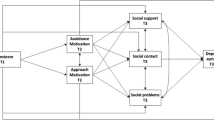Abstract
The present study focused on differences in self-esteem trajectory in early adolescence rather than on average change across all children. Longitudinal data from 128 adolescents were obtained over a 2-year period that encompassed the transition from elementary school to junior high school. Cluster analysis revealed four markedly divergent self-esteem trajectories: consistently high (35%), chronically low (13%), steeply declining (21%), and small increase (31%). Attempts to predict trajectories were only partially successful. Peer social support was the strongest predictor, but its relation to self-esteem appears more circumscribed than had been thought. The discussion considers differences in the experience of early adolescence, as well as implications for the design and evaluation of preventive intervention.
Similar content being viewed by others
References
Abramowitz, R., Petersen, A., and Schulenberg, J. (1984). Changes in self-image during early adolescence. In Offer, D., Ostrov, E., and Howard, K. (eds.),Patterns of Adolescent Self-Image. Jossey-Bass, San Francisco.
Adelson, J. (ed.). (1980).Handbook of Adolescent Psychology. Wiley, New York.
Berndt, T., and Hawkins, J. (1988). The contribution of supportive friendships to adjustment after the transition to junior high school. Unpublished manuscript, Purdue University.
Block, J. (1971).Lives through Time. Bancroft, Berkeley, CA.
Cauce, A. M. (1986). Social networks and social competence: Exploring the effects of early adolescent friendships.Am. J. Commun. Psychol. 14: 607–628.
Crocket, L. J., Petersen, A. C., Graber, J. A., Schulenberg, J. E., and Ebata, A. (1989). School transitions and adjustment during early adolescence.J. Early Adolesc. 9: 181–210.
CTB/McGraw-Hill (1974).Comprehensive Tests of Basic Skills (Form S): Technical bulletin no. 1, Author, Monterey, CA.
Depue, R. A., and Monroe, S. M. (1986). Conceptualization and measurement of human disorder in life stress research: The problem of chronic disturbance.Psychol. Bull. 99: 36–51.
Derogatis, L., and Spencer, P. (1982).The Brief Symptom Inventory (BSI): Administration, Scoring, and Procedures Manual — I. Division of Medical Psychology, Johns Hopkins University School of Medicine.
Dusek, J. B., and Flaherty, J. F. (1981). The development of self-concept during the adolescent years.Monogr. Soc. Res. Child Dev. 46(No. 191, 4).
Eccles, J., Wigfield, A., Reuman, D., and Maciver, D. (1987, April). Changes in self-perception and values at early adolescence. Paper presented at the meeting of the American Educational Research Association, Washington, DC.
Epstein, J. (ed.). (1981).The Quality of School Life, Heath, Lexington, MA.
Epstein, J., and McPartland, J. (1976). The concept and measurement of the quality of school life.Am. Educal. Res. J. 50: 13–30.
Felner, R. D., Primavera, J., and Cauce, A. M. (1981). The impact of school transitions: A focus for preventive efforts.Am. J. Commun. Psychol. 9: 449–459.
Hamburg, B. (1974). Early adolescence: A specific and stressful stage of the life cycle. In Coelho, G., Hamburg, D., and Adams, J. (eds.),Coping and Adaptation. Basic, New York.
Harter, S. (1983). Developmental perspectives on the self-system. In Mussen, P. (ed.),Handbook of Child Psychology: Vol. IV. Socialization, Personality, and Social Development (4th ed.). Wiley, New York.
Hartigan, J. (1975).Clustering Algorithms. Wiley, New York.
Hirsch, B. J., and Rapkin, B. D. (1987). The transition to junior high school: A longitudinal study of self-esteem, psychological symptomatology, school life, and social support.Child Develop. 58: 1235–1243.
Hirsch, B. J., and Reischl, T. (1985). Social networks and developmental psychopathology: A comparison of adolescent children of a depressed, arthritic, or normal parent.J. Abnorm. Psychol. 94: 272–281.
Hirsch, B. J., Moos, R., and Reischl, T. (1985). Psychosocial adjustment of adolescent children of a depressed, arthritic, or normal parent.J. Abnorm. Psychol. 94: 154–164.
Lipsitz, J. (1977).Growing Up Forgotten. Heath, Lexington, MA.
Livson, N., and Peskin, H. (1980). Perspectives on adolescence from longitudinal research. In Adelson, J. (ed.),Handbook of Adolescent Psychology, Wiley, New York.
McCall, R. B., Eichorn, D. H., and Hogarty, P. S. (1977). Transitions in early mental development.Monogr. Soc. Res. Child Dev. 42(No. 171, 3).
McCarthy, J. D., and Hoge, D. R. (1982). Analysis of age effects in longitudinal studies of adolescent self-esteem.Develop. Psychol. 18: 372–379
Newcomb, M., Huba, G., and Bentler, P. (1981). A multidimensional assessment of stressful life events among adolescents: Derivation and correlates.J. Health Social Behav. 22: 400–414
Nottelmann, E. D. (1987). Competence and self-esteem during transition from childhood to adolescence.Develop. Psychol. 23: 441–450.
Offer, D., and Offer, J. (1975).From Teenage to Young Manhood. Basic, New York.
O'Malley, P. M., and Bachman, J. G. (1983). Self-esteem: Change and stability between ages 13 and 23.Develop. Psychol. 19: 257–268.
Rosenberg, M. (1965).Society and the Adolescent Self-image. Princeton University Press, Princeton, NJ.
Savin-Williams, R. C., and Demo, D. H. (1984). Developmental change and stability in adolescent self-concept.Develop. Psychol. 20: 1100–1110.
Selye, H. (1976).The Stress of Life (rev. ed.), McGraw-Hill, New York.
Simmons, R. G., and Blyth, D. A. (1987).Moving into Adolescence: The Impact of Pubertal Change and School Context, Aldine De Gruyter, New York.
Weissberg, R. P., Gesten, E. L., Carnrike, C. L., Toro, P. A., Rapkin, B. D., Davidson, E., and Cowen, E. L. (1981). Social problem-solving skills training: A competence-building intervention with second-to fourth-grade children.Am. J. Commun. Psychol. 9: 411–423.
Werner, E. E., and Smith, R. S. (1982).Vulnerable but Invincible: A Longitudinal Study of Resilient Children and Youth, McGraw-Hill, New York.
Yougman, M. B. (1978). Six reactions to school transfer.Br. J. Educ. Psychol. 48: 280–289.
Author information
Authors and Affiliations
Additional information
Received Ph.D. in clinical psychology from the University of Oregon. Research interests include community psychology, ecology of adolescent development, social networks, and social policy.
Research interests include peer relations and school-based preventive intervention.
Rights and permissions
About this article
Cite this article
Hirsch, B.J., DuBois, D.L. Self-esteem in early adolescence: The identification and prediction of contrasting longitudinal trajectories. J Youth Adolescence 20, 53–72 (1991). https://doi.org/10.1007/BF01537351
Received:
Accepted:
Issue Date:
DOI: https://doi.org/10.1007/BF01537351




